1lumen selects and reviews products personally. We may earn affiliate commissions through our links, which help support our testing.
Wurkkos DL70 review
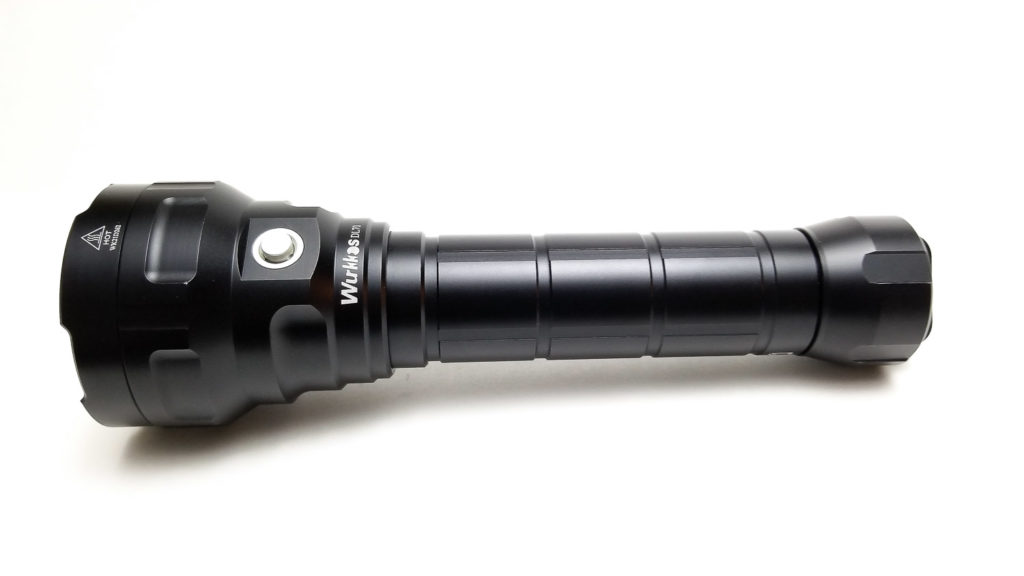
Wurkkos DL70 specifications
| Brand/model | Wurkkos DL70 |
|---|---|
| LED | 4*CREE XHP50.2 (3Volt 6500K) |
| Lumens | 13,000 lm |
| Beam intensity | 63,750 cd |
| Battery config. | 2*26650 lithium ion |
| Material | Aluminum |
| Modes | 4 |
| Blinkies | N/A |
| Reflector | Quad SMO |
| Waterproof | IPX8 (to 100 meters) |
| Review date | June 2021 |
Introduction:
Wurkkos. Aside from being a fun name to say, they are a relative newcomer to the enthusiast flashlight market. However, that hasn’t stopped them delivering some great lights of late, including the Wurkkos TS30 and SBT90.2 equipped TS30S, which Peter reviewed. Although marketed as a standalone brand (they also sell home and life-improvement goods on their webpage), Wurkkos, like Astrolux, does not make their own flashlights. You might be asking who does? If you guessed Sofirn, give yourself a high-five because Wurkkos outsources their production duties to Sofirn. This is a good thing since we all know Sofirn makes solid lights. When I was asked to review something new from Wurkkos with 13,000 lumens, I was all in. However, this one is pretty special: It’s purpose-built for underwater use up to 100 meters. The new DL70 is the top model in Wurkko’s dive light lineup, consisting of the DL40, DL30, WK20 and WK20S models. I don’t scuba dive, but I suspect this will be a good performer out of the water also. Hey, 13,000 lumens is 13,000 lumens whether it’s on land or underwater. With two 26650 batteries in series and a buck driver powering 4 Cree XHP50.2 3 volt emitters, it looks good on paper, but let’s see how it does.
Package quality.
No surprise, like the other Wurkkos lights these days, the DL70 arrived in a pretty simple cardstock box in the familiar Wurkkos orange and white color scheme. No fluff or fanfare at all. Although I was expecting something a little nicer for the price, I’m not surprised since Wurkkos embodies the same packaging and presentation methodology as Sofirn and Astrolux: bare-bones, plain-Jane, just-enough-to-get-by packaging. In the box, the DL70 was wrapped in bubble wrap cushioned with foam on the box bottom with the accessories strewn about inside. Here’s what you get:
- Wurkkos DL70
- 2 spare o-rings
- 2 Wurkkos-branded 5000 mAh button top 26650 batteries (loaded in the light)
- Lanyard
- User manual
- Battery quick start card
- Micro USB charging cable
- 2-bay USB powered lithium-ion charger
Wurkkos sells the light without batteries and the charger bundle for a small discount, but it’s such a small price difference that you might as well get the kit (cheaper than buying a single 26650 these days). I think this is a great move since the DL70 doesn’t have an external charging port and the buyer will have a complete package with no need for extra purchases. The accessories seem to be okay quality, but I’m always suspect of bundled chargers. Also, this light has lots of o-rings, so to include just two spares is a bit miserly. At an MSRP of $105.99 with battery bundle, this is kind of an expensive light.
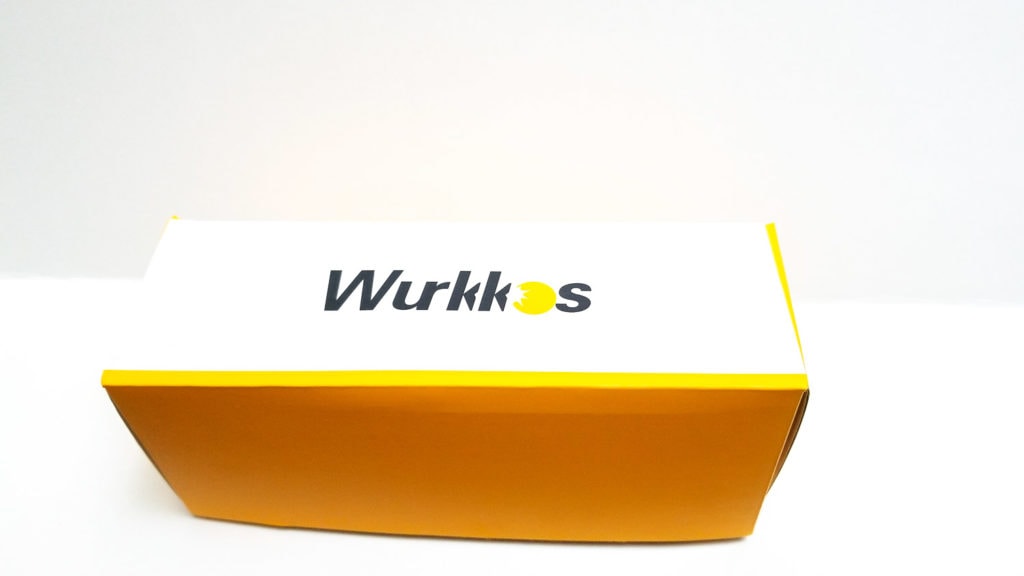
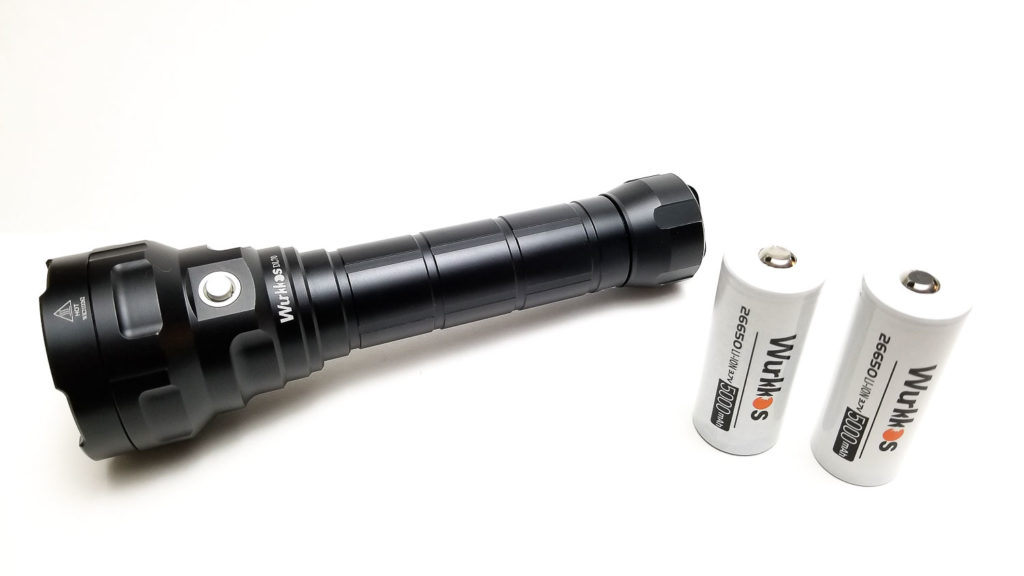
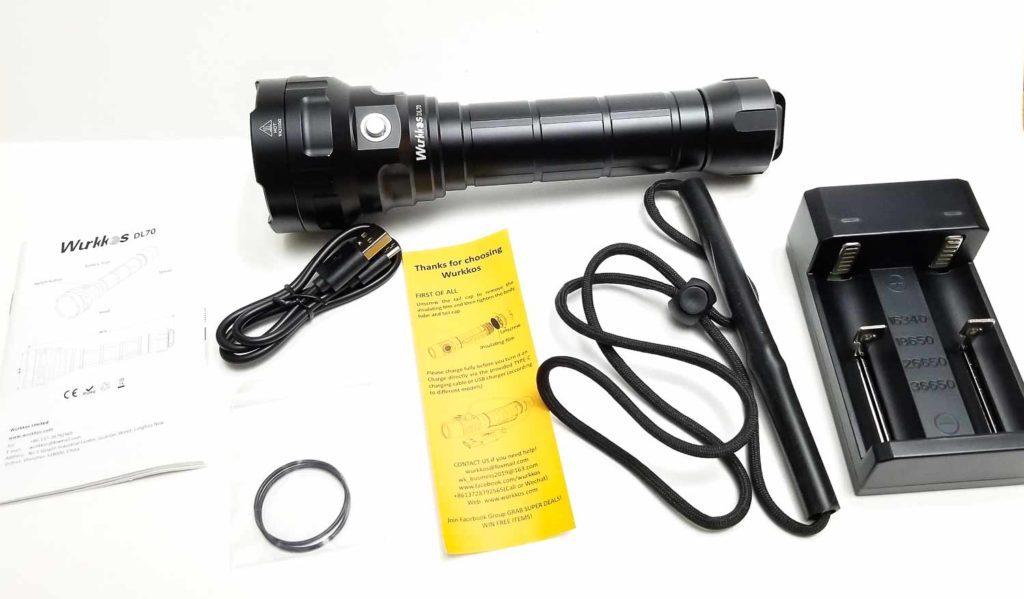
Flashlight in use
This is a big flashlight, think Convoy L6 dimensions. It’s shorter than my 3D Maglite, but longer than my Astrolux FT02S and heavier. Fully loaded it’s over 20 ounces or 1.2 pounds. This isn’t one you’d want to carry around much.
However, for a big light, it handles well enough. It doesn’t feel cheap and seems like there’s a lot of thermal mass in the head. The battery tube walls also seem plenty thick, and I am sure this light could take some abuse. There’s enough gripping surface on the 26650-size battery tube for a good purchase on the light, but it may be a handful (no pun intended) for users with smaller hands. The battery tube has deep circumferential and horizontal grooves machined into it that makes a good gripping area for gloved hands. It is front heavy and the center of gravity is about 2 inches back from the switch, so Wurkkos did a good job keeping it balanced. The lanyard is made from thick (4 mm) nylon cordage with a substantial silicone rubber pad on the wrist end and a very beefy adjustable sliding clasp. This is the most serious lanyard I’ve encountered and looks like you could tow a Ford Fiesta with it. I have no doubt this would keep the DL70 attached to your wrist.
The front-mounted e-switch is interesting. The manual says it’s a magnetic switch, but Wurkkos says it’s designed as a negative-positive pressure switch, so the positive pressure present inside the light head keeps water out. It certainly feels that way when pressing it because there’s no clicking, audible or tactile, and the action is bouncy like there’s a spring underneath. The lack of click makes it feel vague and almost touchy. The button is metal and protrudes a fair bit out of the head. A diver wouldn’t have any issues using it with gloved hands. I donned some neoprene diving gloves to test this, and didn’t have any trouble manipulating the switch or handling the light. It behaves like a reverse-clicky, so it doesn’t turn on until the button is pressed and released. The travel is pretty long (about 4 mm), and you need to press it all the way down to change modes or switch on and off.
A big lanyard needs a big lanyard hole, right? Well, Wurkkos obliged and gave you more of a lanyard arch! It’s not flat on the bottom, so tailstanding is a no-go, but what it will do is handily accommodate a huge lanyard or any other method of retention.
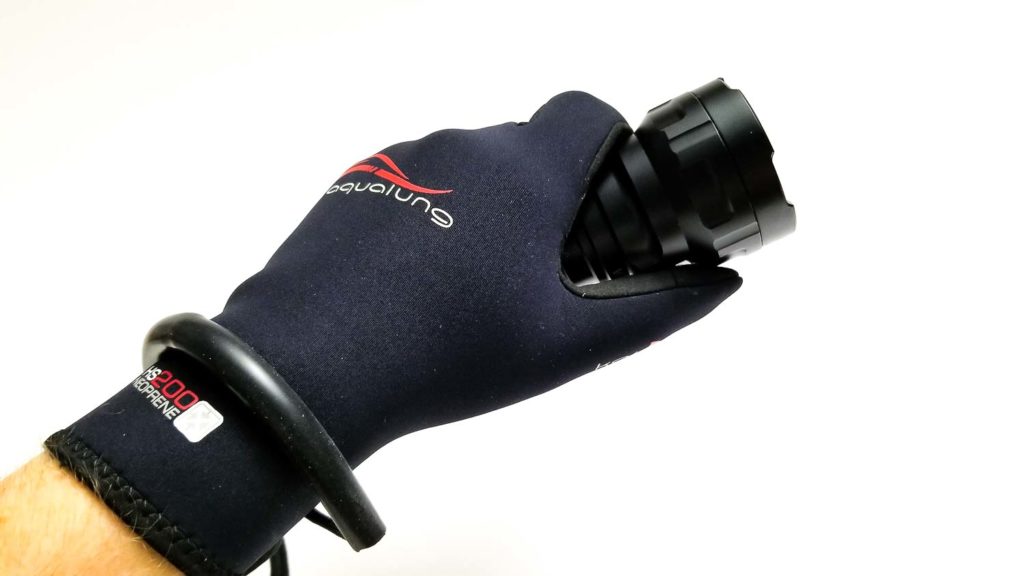
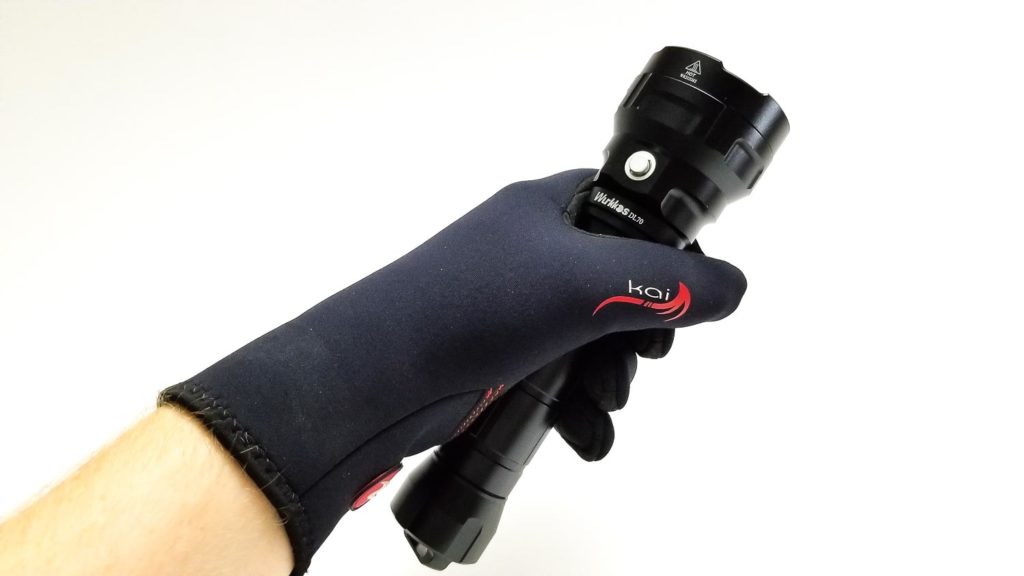
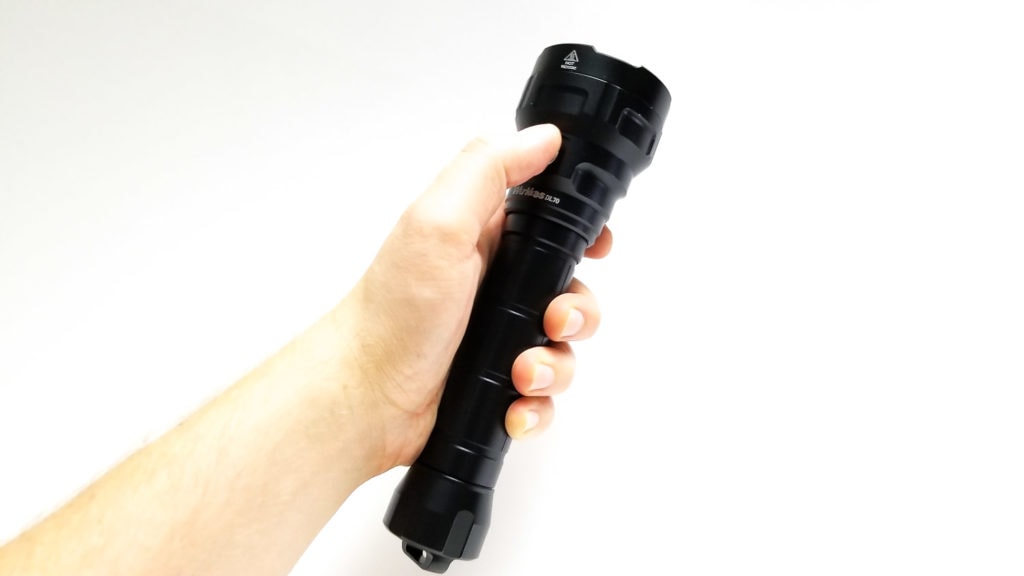
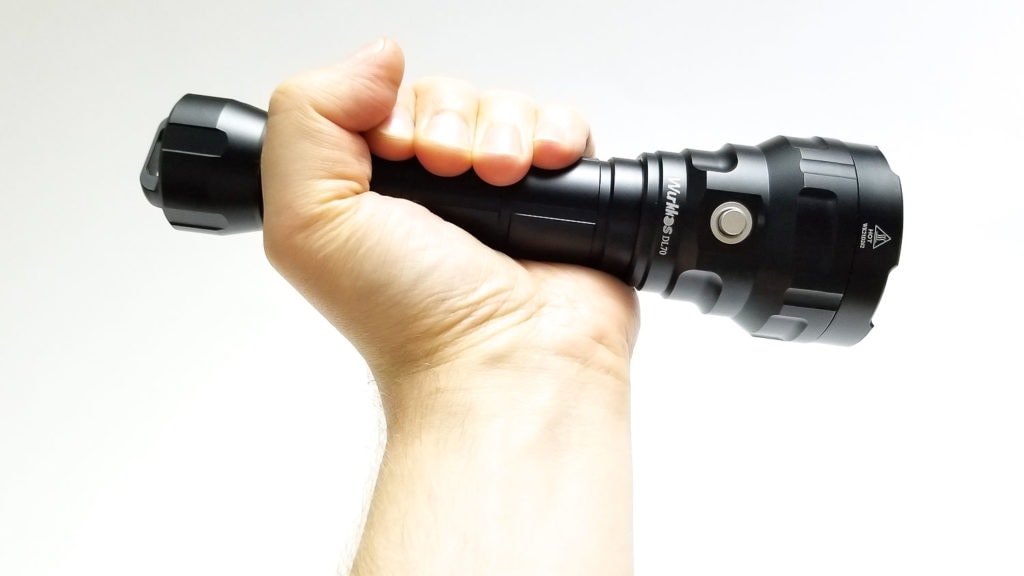
Build Quality, and Warranty
This is the first Wurkkos light I’ve reviewed, but I own a Sofirn light, and I can say the quality is comparable, after all, Sofirn is Wurkkos (or is Wurkkos Sofirn?). Overall, the machining is perfectly acceptable. There were some small imperfections on the head, and the tailcap near the lanyard hole was rough with visible machine marks under the anodization. Thankfully, there aren’t any sharp edges anywhere on the light, and all the parts fit together fine with no major gaps or uneven joints. It fails my Maracas test because those two 26650 batteries rattle away inside the tube with aplomb.
The light is made from durable 6061-T6 aluminum alloy with deep black type III HA anodizing. The finish is semi-gloss, but not too glossy. It’s similar to my Sofirn SP10S, and it’s pretty flawless, but there were a couple dings on the head near the bezel, and the anodizing near the front and rear threads wasn’t the cleanest. That aside, I think the finish is nice and should hold up well to rough use. This isn’t meant to be a showpiece shelf queen or EDC light to show off to your friends, and I don’t think sea creatures care about that either.
The light breaks down into three parts: head, battery tube, and tailcap. This being a purpose-built diving light, there are a bunch of o-rings. I counted seven total: 2 o-rings sealing the tailcap, 2 sealing the head, and 3 o-rings sealing the bezel to the head. The threads are long, huge square cut deals, and fully anodized, so you can manually lock out the light. They were liberally lubed also, so no issues with smoothness, and this also aids in waterproofing. The long threads means it takes a full 6 turns to remove or replace the tailcap. I tried unscrewing the bezel with my hands, but it’s probably sealed with sealant, which is fine since that improves water resistance. Aside from the battery, there’s no user-serviceable parts on this light.
Since this is a diving light, the IP rating should be pretty robust, with protection against continuous immersion. The DL70 is rated for IPX8, so continuous immersion shouldn’t be an issue, but IP ratings can get a bit ambiguous. For more information on ingress protection ratings, check out this resource: https://cobotsguide.com/ip-chart/#liquids. In the DL70’s case, the ‘X’ is for solid particle ingress, but the important one, ‘8’ specifies immersion at depths greater than 1 meter. This is totally subjective and relative to the manufacturer’s testing and certification. Wurkkos says the DL70 is good down to 100 meters (about 330 feet), and the nerd in me says that at that depth, the water is exerting over 140 pounds per square inch of pressure on this light. That’s a lot of force and the water is trying awfully hard to get inside.
Although nowhere near an exhaustive evaluation of the water resistance, I dropped the DL70 in a 5 gallon (18.92 liters) bucket for several hours. That’s about 16 inches of water, so barely scratching the surface of the true IP rating, but I couldn’t find any traces of moisture or water inside when I broke the light down.
The tailcap spring PCB is screwed with two (probably stainless steel) screws, and there’s two springs for the current path, with a very substantial gold-plated spring and a smaller one underneath. These were bigger than the ones on my FT02S. It’s nice to see a dual spring arrangement for lower resistance since this light will pull a lot of amps. The driver only has a gold-plated button for the positive contact.
I couldn’t find any evidence of a warranty in the packaging or included literature, but the manual does say that intentional damage isn’t covered by the warranty. This probably falls into the nexus of if it breaks/fails and it isn’t your fault, send it back for replacement or repair.
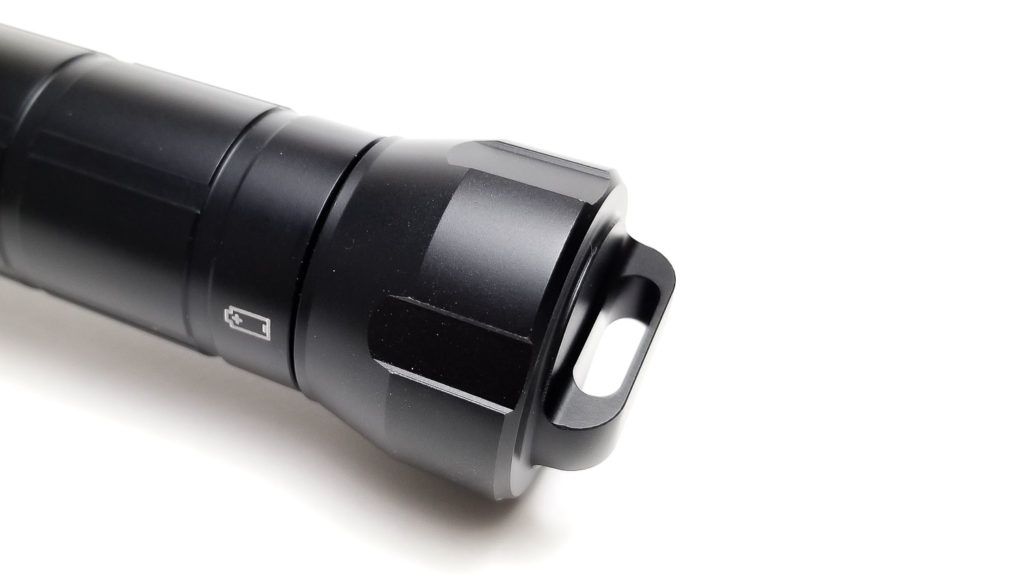
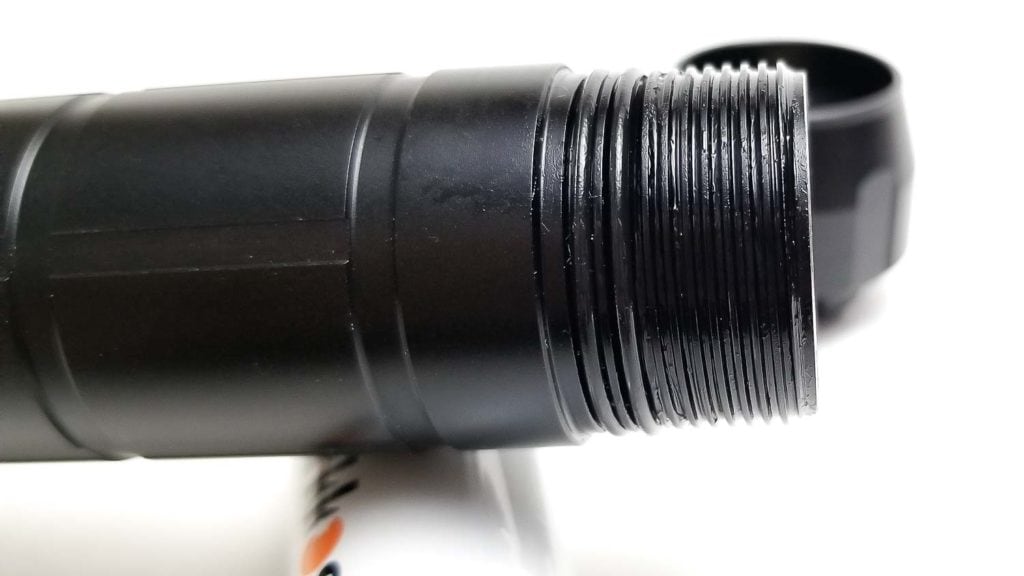
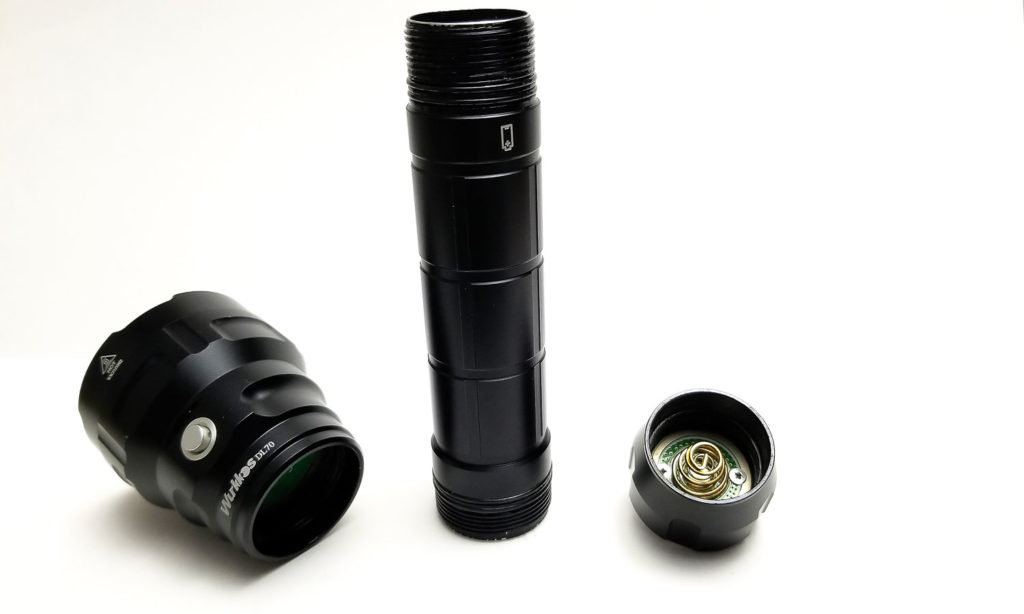
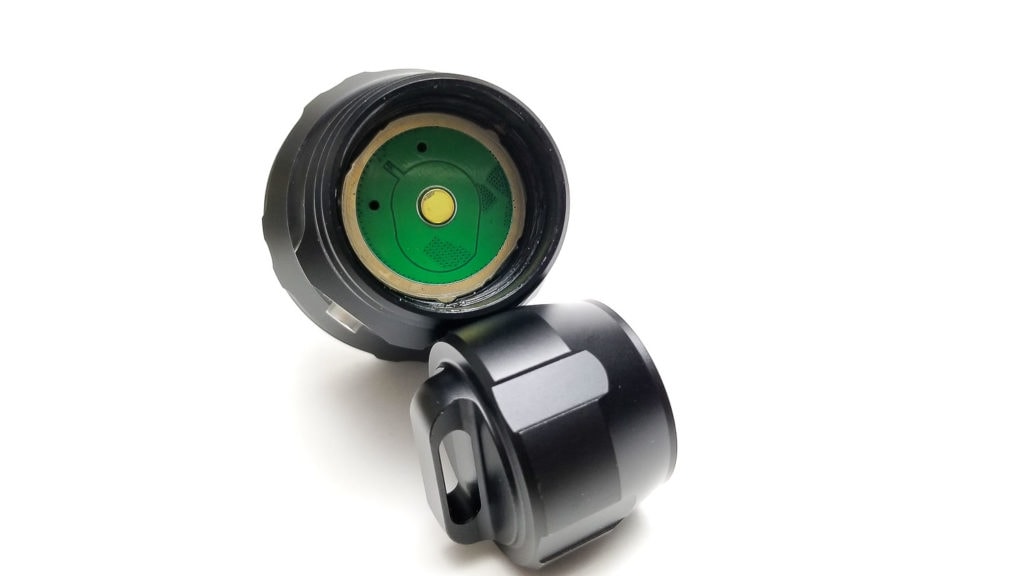
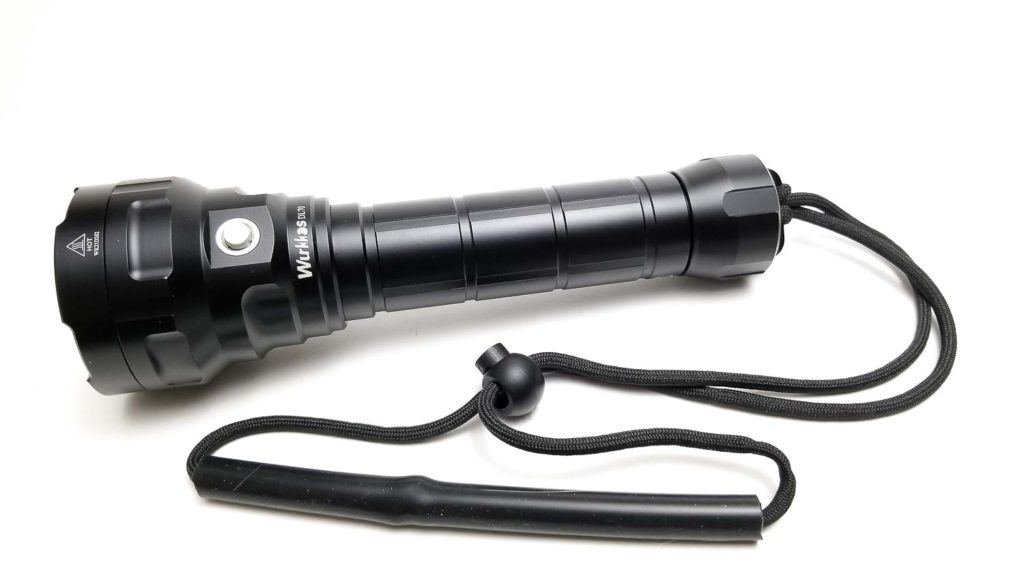
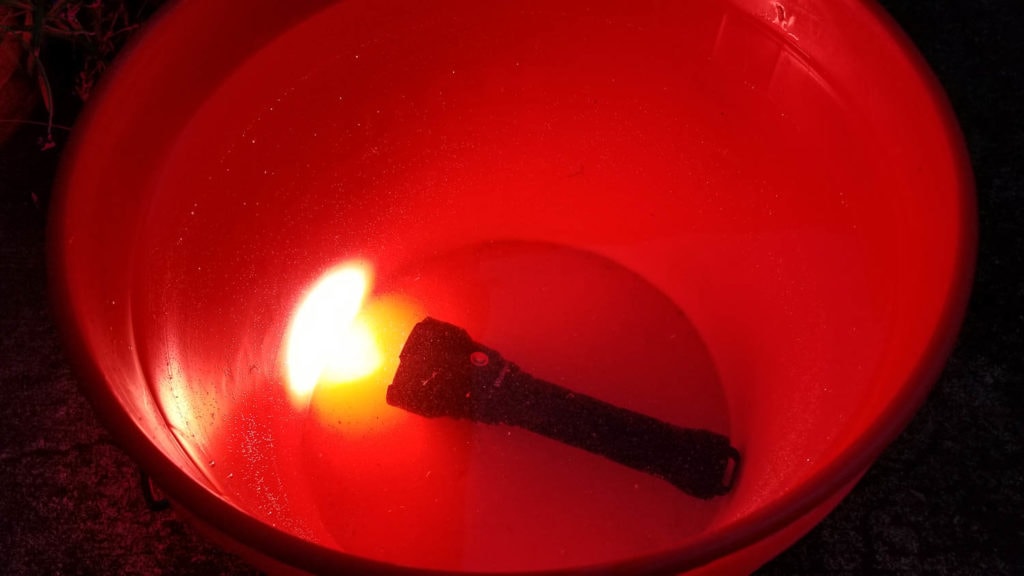
LED, Lens, Bezel, and Reflector
Wurkkos is one of the faithful manufacturers who are happy to divulge their LED particulars. The DL70 employs the venerable Cree XHP50.2 LED in 3 volt configuration. The tint isn’t specified, but they look an awful lot like 5700-6000K, so thumbs-up for that since most of the 3 volt 50.2’s we get now are 6500K and way too cool.
The 4 LEDs sit perfectly centered in a deep flawless quad 60 mm SMO reflector that looks similar to my old SRK, but a little wider and taller. It’s topped with a mineral glass lens that’s not (that I could easily see) AR coated. Maybe Wurkkos had a reason for this? I couldn’t get the bezel off to check the lens thickness, but I am sure it’s properly thick. The blacked out bezel itself is pretty substantial and it’s sporting some obligatory crenulations as well.
The quad SMO reflector gives the DL70 a nice versatile beam, with great throw and very generous spill. It’s typical of what you see on an SRK or other quad reflector of this type, but I did notice it’s pretty free of artifacts (unlike my FT02S). The hotspot isn’t thrower-tight, but focused, and of course you have the Cree XHP SMO syndrome with an obvious tint shift. To be fair, it’s no worse than on my Astrolux FT02S so it’s only annoying on white walls. Combined with the sheer amount of light, not-too-cool color temperature, and versatile beam, the DL70 would be equally at home on land or in the hands of a diver.
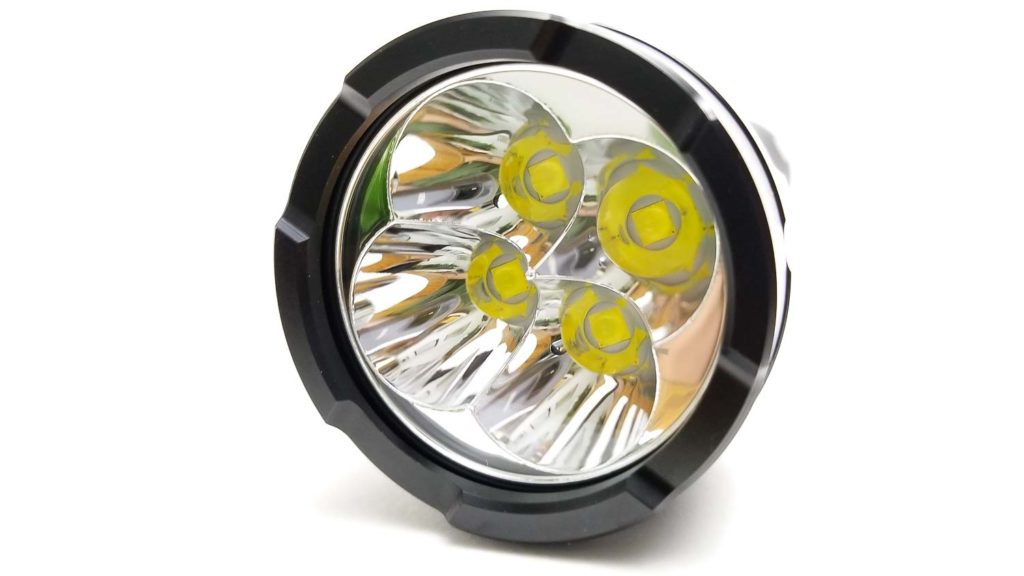
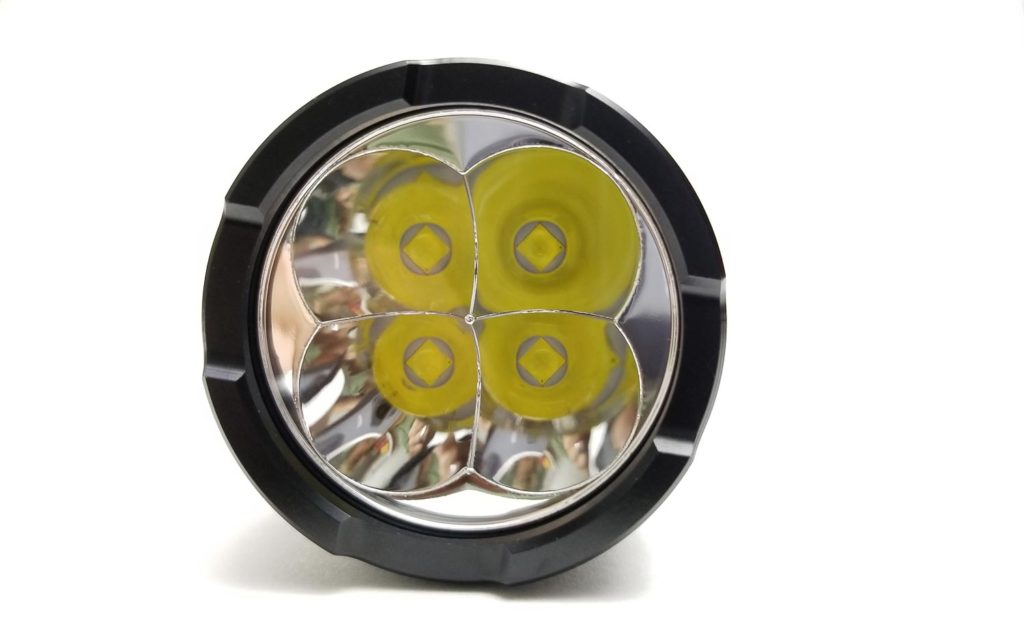
Dimensions and size comparison
- Length: 20.9 cm / 8.22 inches
- Head diameter: 6.0 cm / 2.3 inches
- Body diameter: 3.3 cm / 1.30 inches
Weight:
- With included batteries: 585 grams / 20.6 oz.
- Without batteries: 393 grams / 13.8 oz.
Flashlight size comparison
Size compared to other popular flashlights
Left to right: Thorfire C8, Astrolux FT02S, Wurkkos DL70.
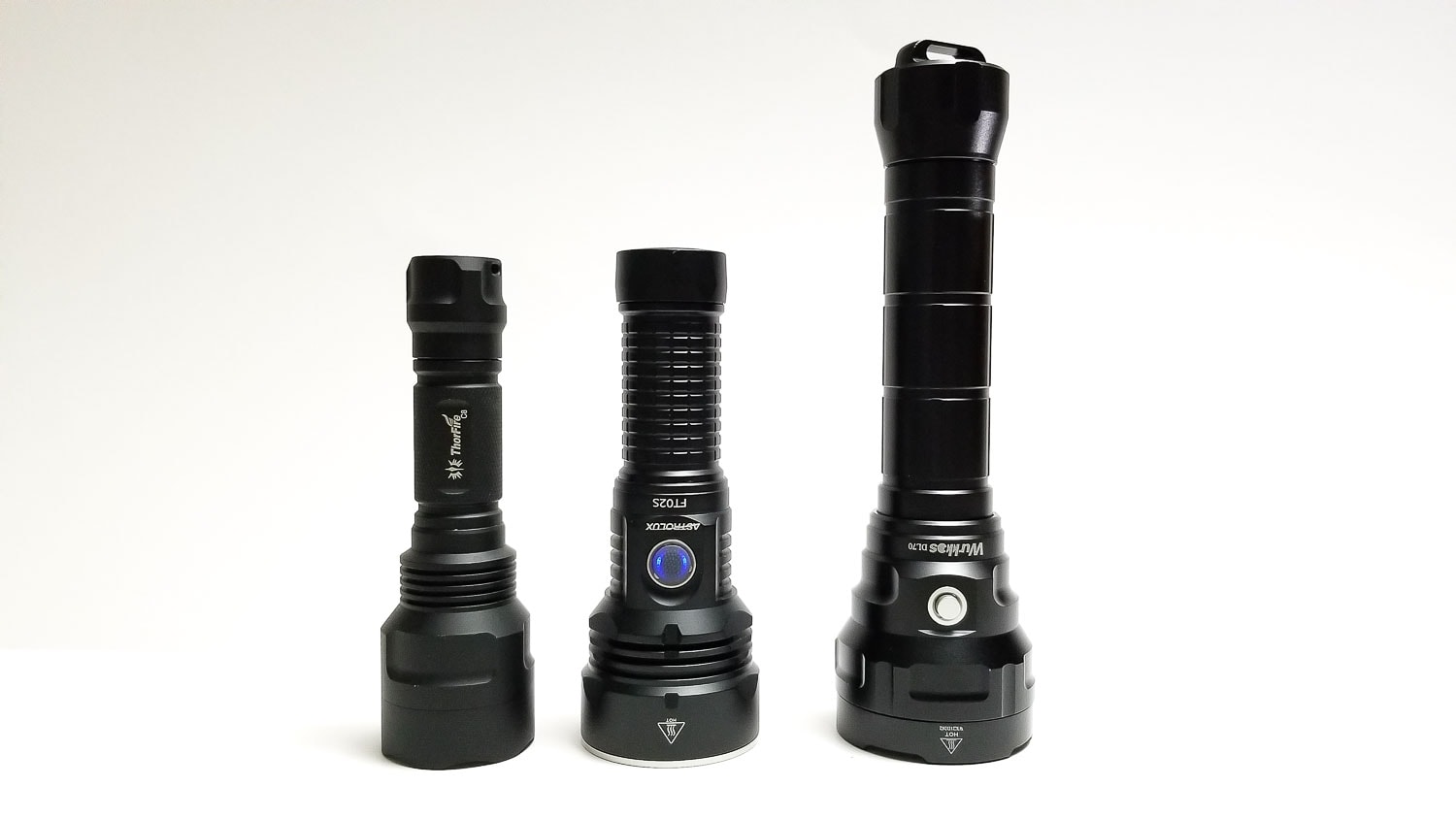
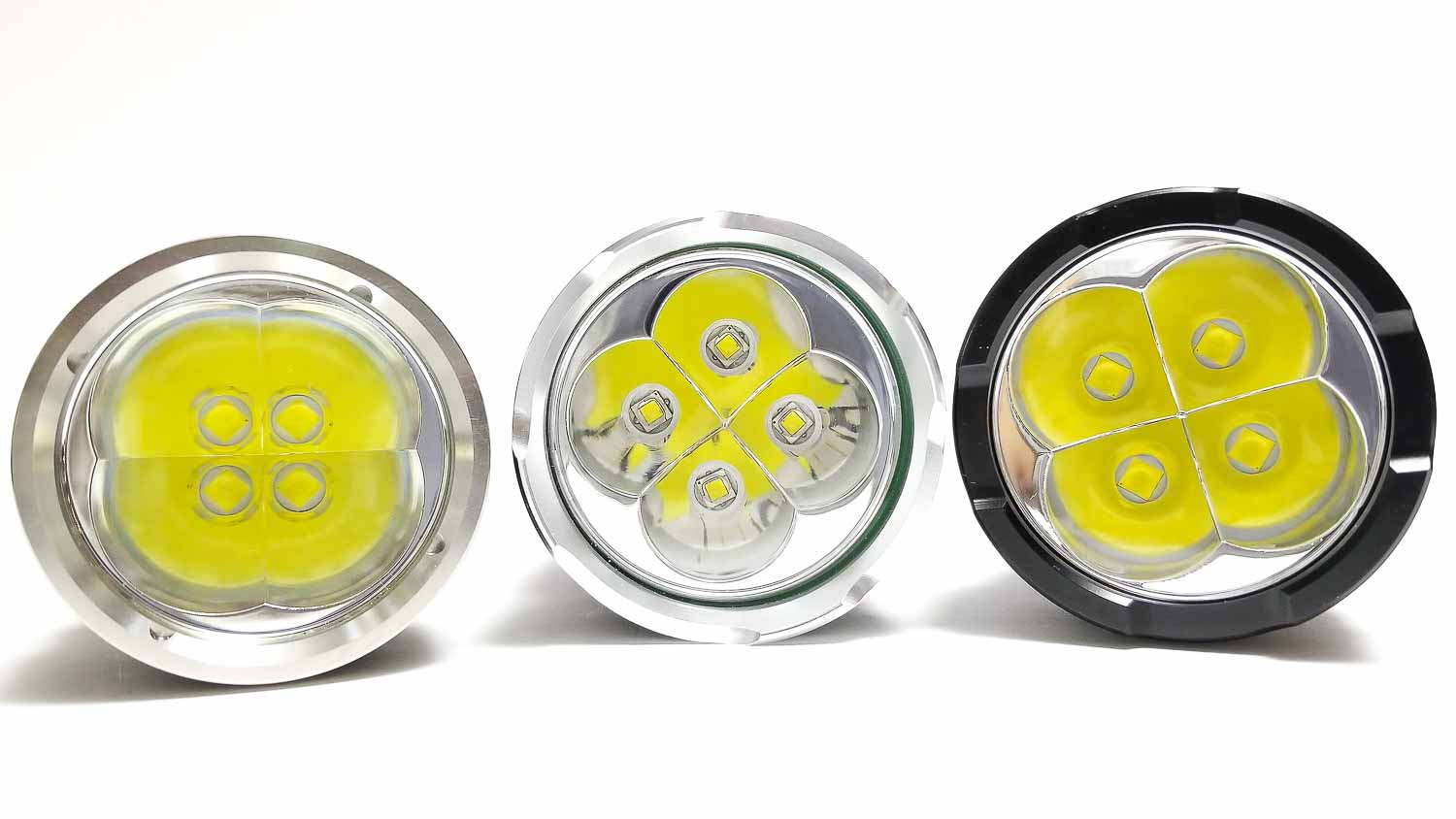
Driver & User Interface:
The DL70 employs a buck driver for the LEDs, stepping down the 8.4 volts to 3-something volts for the LEDs. It’s a pretty stout driver and capable of high output.
The user interface is very simple, and I must say that after rummaging through Anduril2 (I felt like I had to go to flashlight UI school for that one), the DL70 UI is a breath of fresh air. The UI is delightfully simple, and the mode spacing is very good with no huge jumps in brightness.
Modes: Low, medium, high, and turbo. Yep, that’s it. I’m using ‘press’ instead of click since the button doesn’t click.
From OFF:
- Press and hold: N/A
- Single press: Turns on in last mode
- Double press: N/A
From ON:
- Press and hold: Turns off after 1 second
- Single press: Switches to next mode L-M-H-Turbo-L
- Double press: N/A
Mode memory:
- Yes, mode memory. The light turns on in the last used mode
Low voltage warning:
- Yes, the light will give a visual notification when the voltage is low, flashing twice every minute until shut down (around 6 volts)
Strobe/blinkies
- None
Lock-out mode:
- None. Unscrew the tailcap ⅛ turn to manually lock out.
PWM
- Yes, fast PWM which is not visible to the naked eye
Additional info: I think this UI is perfectly suited for a diving light since this is essentially a professional tool and divers have more important things to concern themselves with other than “Hey, how do I make it brighter?” I think the mode spacing is great also. The driver does have ATR (automatic temperature regulation) set to 55 C, so using it on land won’t cause a meltdown. It will be interesting to see how it performs. Oddly, I’m surprised to see PWM on a CC buck diver. The LVP kicks in around 6 volts (should be 3 volts per cell-roughly, but more on that later).
Batteries & Charging
The DL70 takes any battery you want as long as it’s two 26650 lithium ion cells in series. There’s no onboard charging, which makes sense because it’s one less ingress point for angry water molecules. You’ll need a charger that accommodates 26650 batteries, but if you don’t have one, no worries because Wurkkos will sell you one with two batteries as an optional bundle. My review light came with this bundle, consisting of two Wurkkos-branded 5000 mAh button top cells along with a mystery unbranded 2-bay battery charger. The batteries were loaded in the light with an isolator on the negative contact and were sitting at 3.7 volts which is ideal for long-term storage.
I put the batteries in my Zanflare C4 analyzing charger to check internal resistance and one read about 40 milliohms and the other was around 90. Hmmmm. This could be problematic since the DL70 uses a series configuration and both cells need to be evenly matched (mostly identical) for maximum performance. Imbalances can cause issues with reduced cell life and poor performance. We will see how or if it affects the runtime.
Another anomaly worth mentioning was when I ran them through the analyzing charger after a runtime test. At the end of the charging, they read over 5500 mAh, so it appears either they are mislabeled or these are the wrong cells. Either way, I’ll take the extra capacity.
I don’t have any other 26650’s to test whether protected cells fit, but the manual says 21700 cells don’t fit, so I’d venture that 70 mm long cells won’t fit. The included charger is pretty basic, and attentive readers will recognize it as the same one Sofirn includes in their battery/charger bundles. It’s micro USB powered (seriously, in 2021?) and each slot is rated for 1 amp charge rate. It will accommodate cells 43 mm to 65 mm long and there’s a single LED indicator on each slot for charge status: Solid red for charging and green for charged. You need a minimum 2 amp wall adapter for this charger to get the full charge current. The charger worked okay and will get you started, but it’s slow, and when I tested the included batteries after charging, one read 4.2 volts on the nose, but the other read 4.22. That is a little high and over time that would reduce the battery lifespan from overcharging. I recommend getting a name-brand charger capable of charging at 2 amps or more for these high capacity cells.
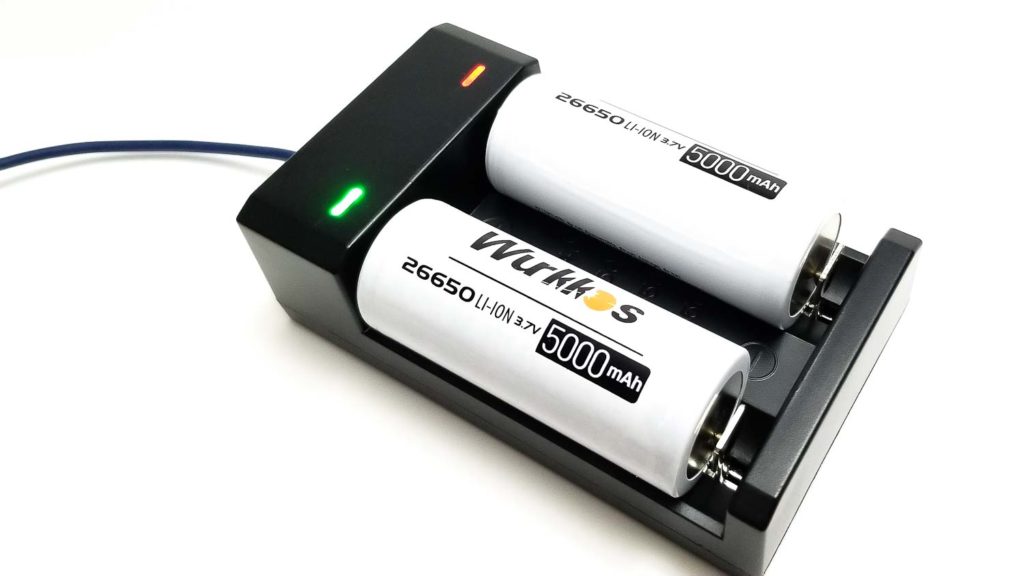
Performance
Okay, we all know 4 XHP50.2 LEDs can produce a ton of light and Wurkkos specifies 13,000 lumens for the DL70 on turbo.
Amp measurement
Current measurements were taken in the traditional way using my Fuiy FY219 TRMS clamp meter with a short piece of 12 gauge wire in a loop. The parasitic drain was taken with my Radio Shack TRMS multimeter with short pieces of 16 gauge wires inserted directly in the meter.
All amp measurements taken at 30 seconds.
- Low: 318 mA
- Medium: 1.15 A
- High: 4.5 A
- Turbo: 11 A (20.6 A at 0 seconds)
Parasitic drain:
0.58 mA
Runtime graph
I conducted the runtime test using the 30 centimeter integrating sphere with the Digi-Sense 20250-00 data logging lux meter. I used the fully charged 5000 mAh included batteries and tested Low, Medium, High, and Turbo mode.
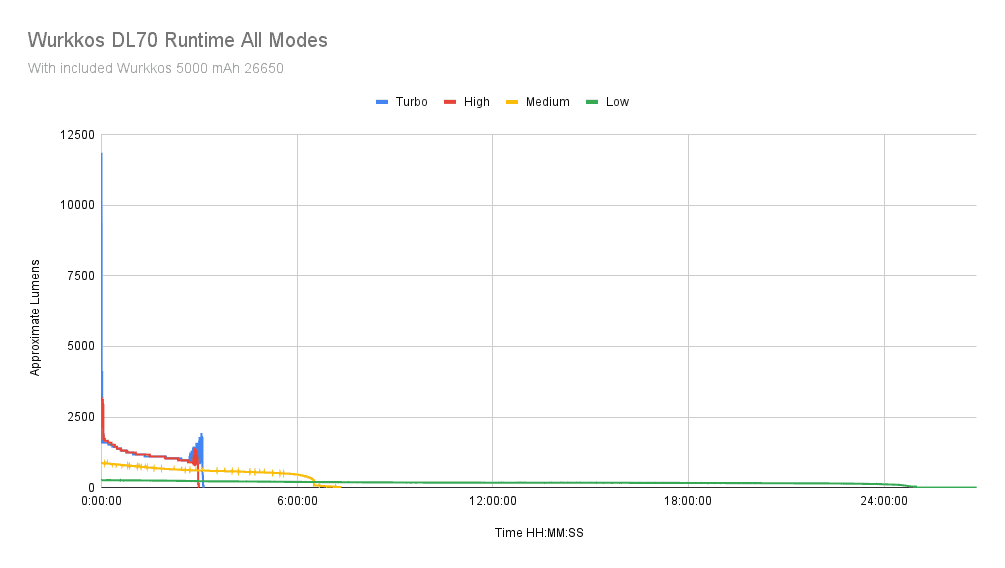
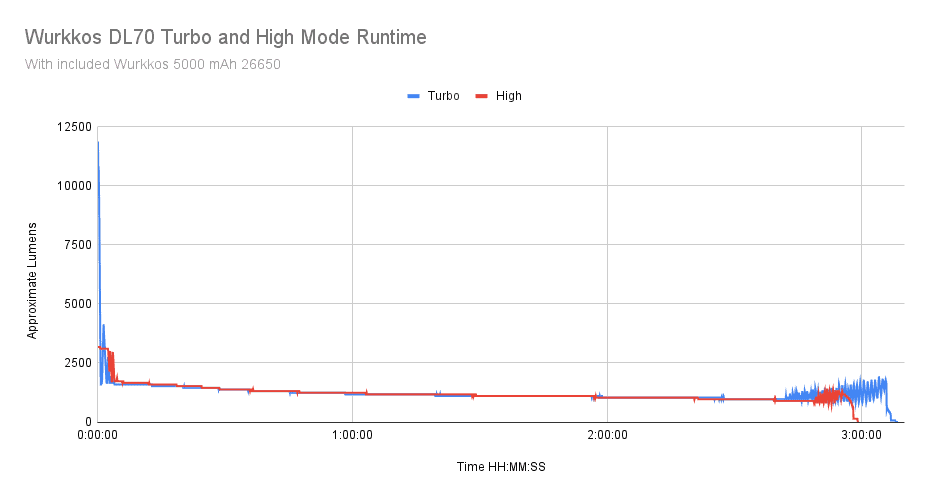
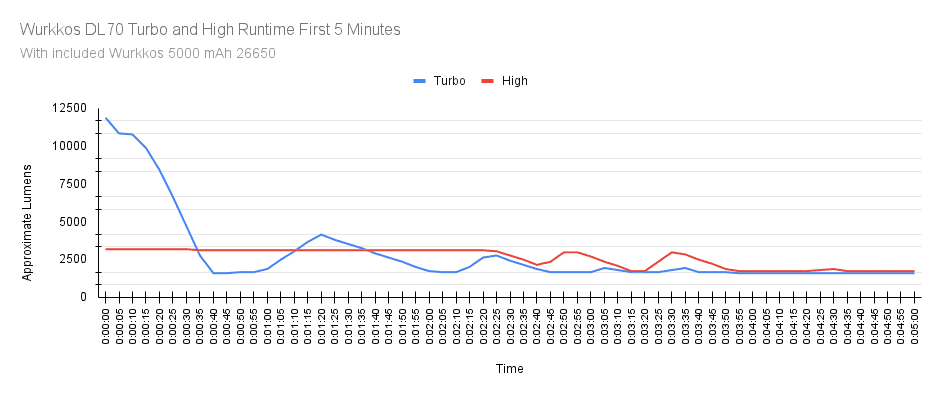
Turbo started at a hair under 12,000 lumens at 0 seconds, and started ramping down around the 15 second mark where it was down to under 10,000 lumens. Ambient temperature was around 24 C, and by this time I measured 40 C at the head. For the next 15 seconds the output really ramps down and at 25 seconds the light is making 6624 lumens and sitting around 40 C, but still nearly sustaining 60% of the original output. Not bad! However, around the 40 second mark the output drops like a rock down to just 1587 lumens as the internal temperature rises to around 55 C. As the light cools, the output rises again to over 3000 lumens over the next 25 seconds. The change is noticeable, but smooth. The highest temperature I recorded was a hair over 58 C. It seems Wurkkos has done a good job with the ATR as the graph doesn’t show a ‘sawtooth’ or rollercoaster pattern indicative of wild changes in output we have seen on previous Wurkkos/Sofirn lights. The throttling tapered off at the 3 minute 35 second mark with gradual stepdows for the remainder of the runtime as the batteries drained. The flat plot line shows the driver regulating the output until the input voltage drops below 6 volts and the light shuts off after 3 hours, 7 minutes. Wurkkos claimed 2 hours 5 minutes, so I got quite a bit more, probably due to the ‘upgraded’ batteries. I’ll take it!
High was very similar to turbo, but Turbo outlasted High. Hmmm. I think this is because High mode maintains a higher output longer so more of the batteries’ energy was depleted earlier in the test. The test started at 3174 lumens and the output remained over 3000 lumens for over 2 minutes. The ATR kicked in and started throttling at the 3 minute 15 second mark, with gradual step downs over the duration of the 2 hour 59 minute runtime. As mentioned, Turbo lasted a full 8 minutes longer. Wurkko’s advertised runtime is 2 hours 33 minutes.
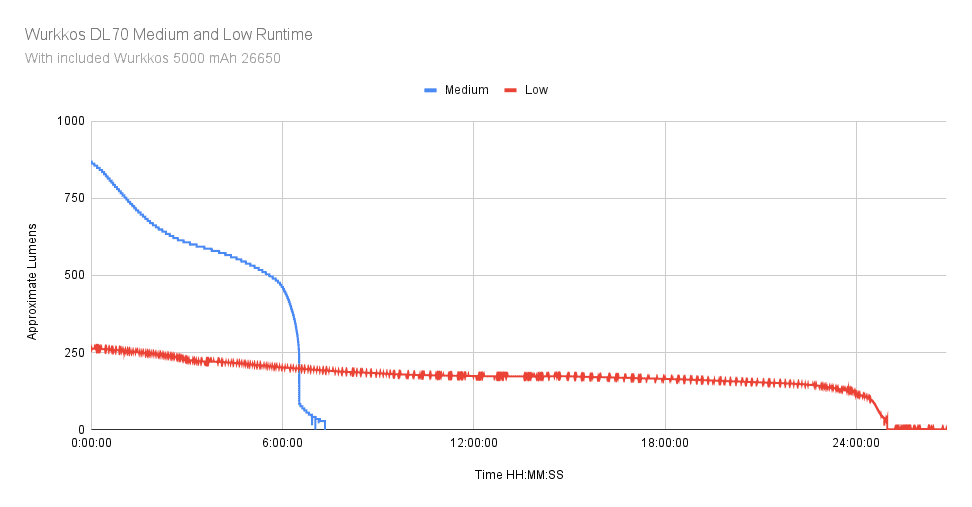
Medium and Low behaved similarly to each other. Medium started at 862 lumens and held that for over 5 minutes. Impressive! ATR was not as aggressive as with Turbo and High, so you get the same boring CC driver runtime profiles. What’s impressive is this mode holds over 800 lumens for over 40 minutes and over 600 lumens for 3 hours. That’s plenty of light for most tasks. Total runtime was 7 hours 19 minutes compared to Wurkko’s 5 hour 24 minute advertised. Low ran for over 24 hours, starting at 260 lumens and holding over 200 lumens for 6 hours. Heat was not an issue here, so the output is very steady. Once again Wurkko’s claimed runtime is way off. Total time was 26 hours 49 minutes compared to Wurkko’s 18 hours 9 minutes. I’m not sure where the discrepancy is in Wurkko’s testing, but maybe it’s down to the batteries I got being 5500 mAh+.
So, what did we learn? Constant current drivers behind high capacity batteries are capable of long runtimes with consistent output. I’m impressed with the refined and mostly unobtrusive ATR and heat management. For example, on High, the tube is around 50 C, which is a bit warm, but still cool enough to be hand held. The LVP works fine also, pulling the plug around 6 volts after some visual notifiers (evidenced by the blips towards the end of the runtime graphs). I could also use the light after all tests, albeit with reduced outputs, but enough to get you by until you can get new batteries. This is important since when diving, your flashlight should last longer than your air supply!
I noticed one worrying fault. After the runtime tests the cell voltages were not equal. It’s okay for the voltages to be off a few millivolts, but after the tests, one cell read 2.3 volts (up to 2.8 after a short rest), and the other read 3.4 volts. Changing the cell order did not change this, and it confirms my aforementioned suspicion that a weak cell with high internal resistance is being discharged more quickly than the other. In a series configuration, if one cell dumps faster than the other, the diver will drop out of regulation and trigger LVP before both cells have a chance to equally (fully) discharge. This is bad for a couple of reasons: One, suboptimal runtime and diminished performance are both major drags, but worse, the weak cell can be damaged from over-discharging. As a rule, lithium-ion cells should never be discharged below 2.5 volts! I don’t doubt Wurkkos uses batteries from reputable manufacturers (Sofirn does), so maybe I got a bad egg.
Lumen measurements (for each mode)
For the lumen test, I used my home made 30 cm integrating sphere calibrated with a light of known output using the Digi-Sense 20250-00 data logging lux meter using the included fully charged batteries. Readings were taken at 30 seconds. I captured the turn on reading for turbo since the output drops so quickly.
| Mode | Measured Lumens | Advertised Lumens |
|---|---|---|
| Low | 275.31 | 450 |
| Medium | 869.4 | 1300 |
| High | 3174 | 4000 |
| Turbo | 4968 (11,868 at 0 seconds) | 13,000 |
Throw numbers:
Throw was measured at 5 meters indoors using the Uni-t UT383S lux meter. I used the fully charged included batteries for all tests. All readings were taken at 30 seconds.
| Mode | Measured Throw | Advertised Throw |
|---|---|---|
| Low | 1,825 cd, 85.44 meters | 1841 cd, 92 meters |
| Medium | 5875 cd, 153.29 meters | 5791 cd, 152 meters |
| High | 18,325 cd, 270.73 meters | 19,266 cd, 278 meters |
| Turbo | 41,675 cd, 408.28 meters (85,400 cd, 584.46 m at turn on) | 63,750 cd, 505 meters |
I was surprised by the turbo reading. I beat Wurkkos’s number at turn on, but came in under it at 30 seconds. Still, not too shabby. I did run the turbo test twice, letting the batteries rest in between a few minutes and got the highest figures the second test.
Beamshots
I compared the DL70 to another quad XHP50.2 light, the FT02S, the triple SST40 Astrolux EC03, an old Skyray King with quad XM-L, and the Imalent R30C with triple Luminus SST70.
- Outdoor shots: The fence is about 95 meters away. The FT02S and DL70 completely thrash the other lights on output, and we see the DL70 has very good throw to boot!
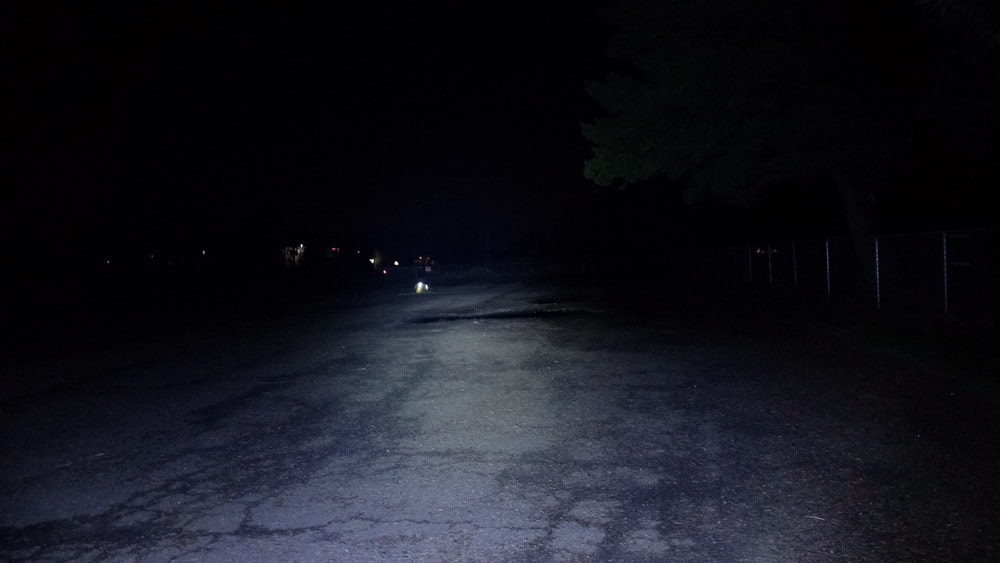
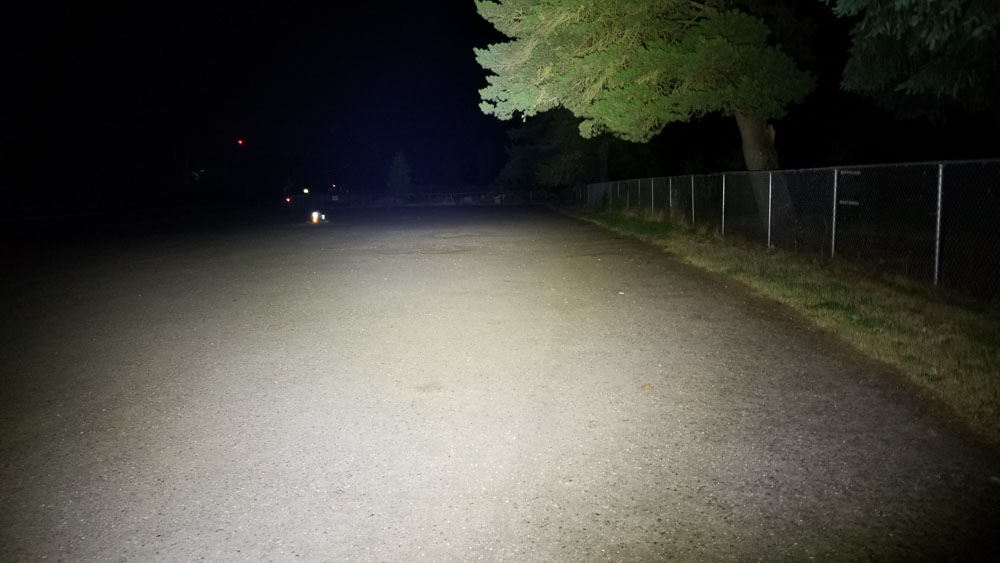
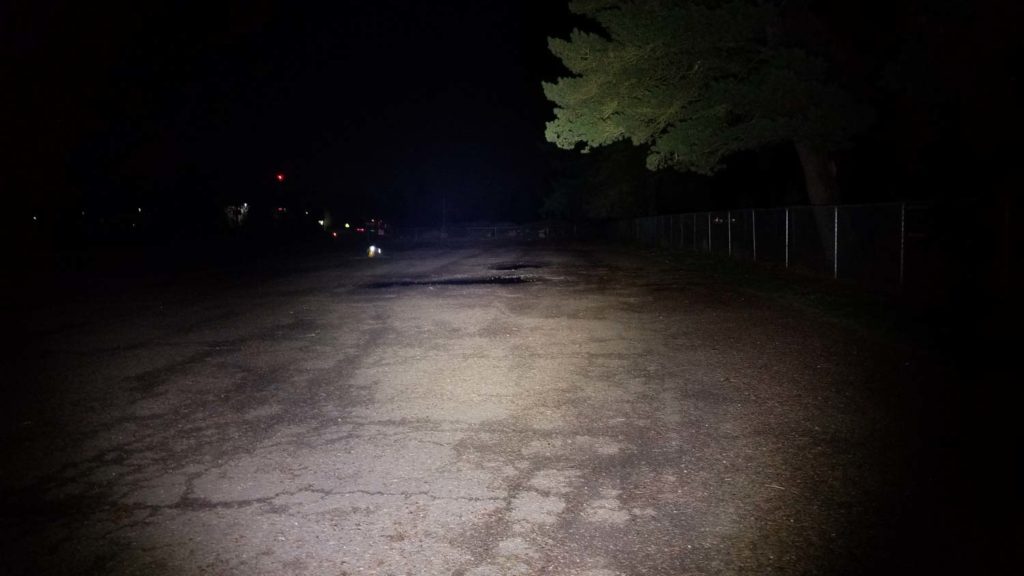

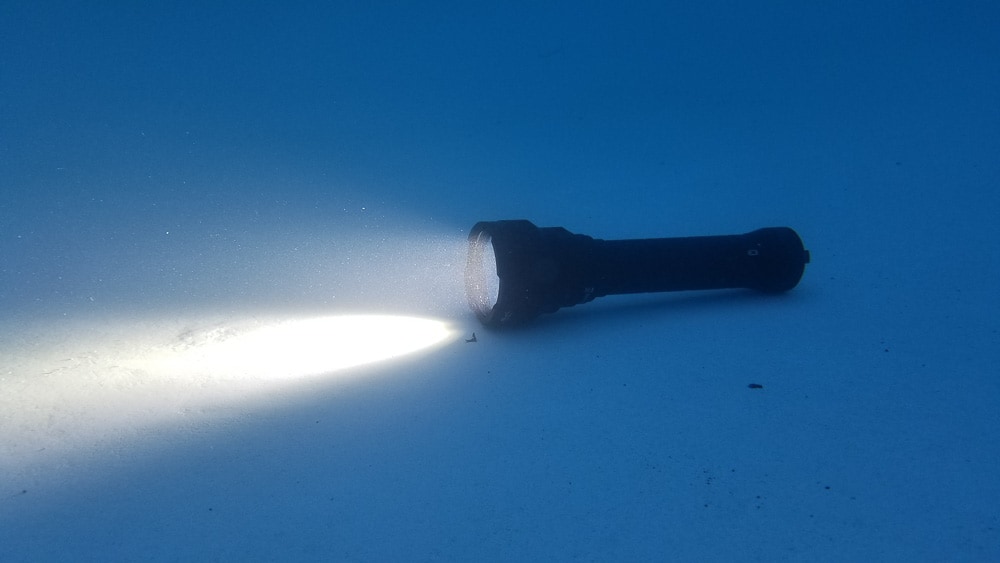
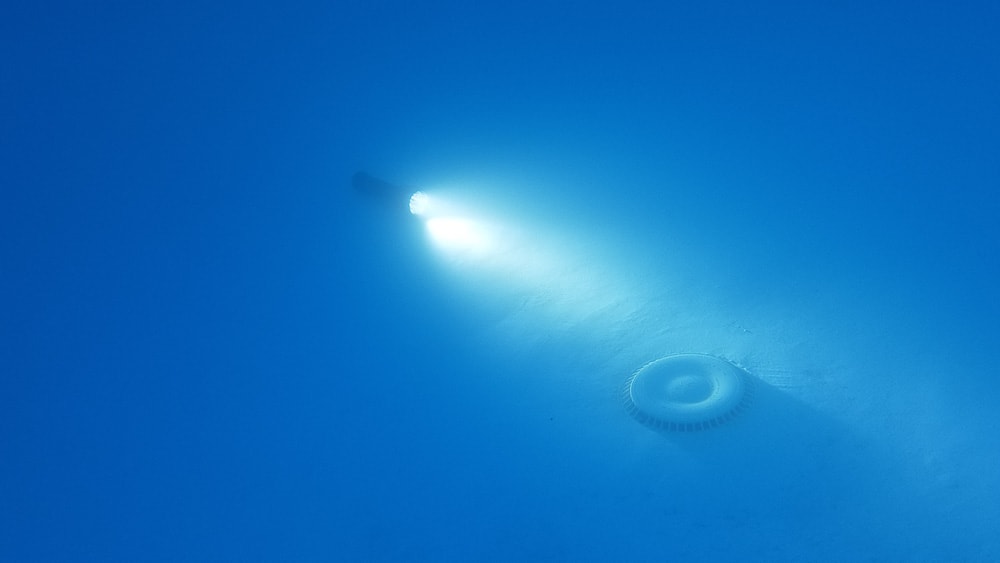
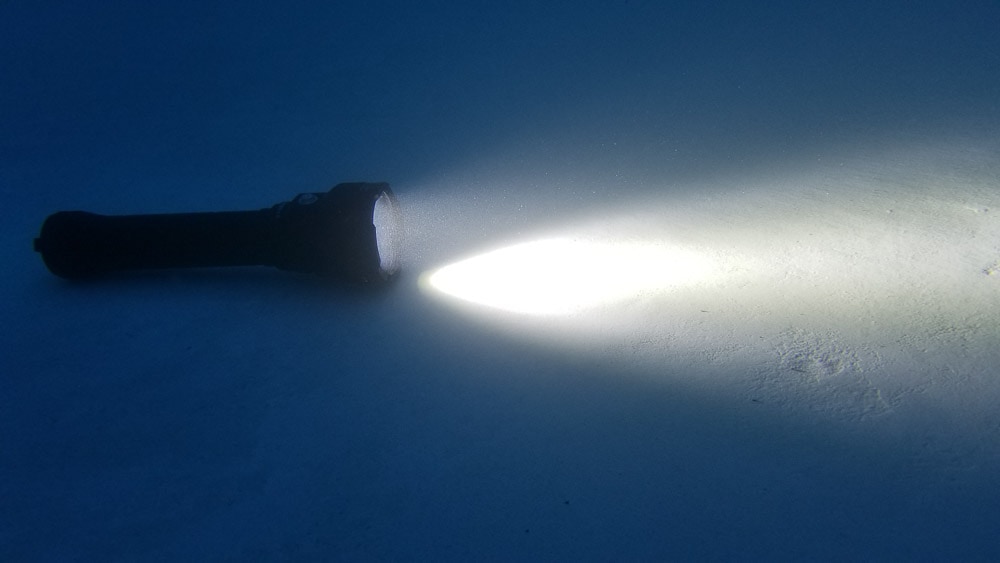
Disclaimer: This flashlight was sent to me for review at no cost by Wurkkos. I have not been paid to review, nor have I been holding back on problems or defects.
Final Verdict
Pros
- Decent build quality
- Useful and simple UI
- Temperature regulation works great
- Extremely bright
- Nice beam
- Waterproof to 100 M
- Battery/charger bundle is a good value
Cons
- Switch takes some getting used to
- Didn’t meet lumen ratings
- One battery had quality issues
- Charger is slow and micro USB powered
Explanation on star ratings:
1: Avoid: my phone flashlight would be a better choice – 2: Poor: significant defect or issues, much better options available at the same price – 3: Average: some defects or issues – 4: Good: recommended (minor issues) – 5: Great: highly recommended

4.5 stars: ★★★★⋆
Wurkkos, although a relative newcomer to the flashlight scene, has put Sofirn’s manufacturing know-how to good use and brought to market affordable and high performance flashlights. I think the DL70 appropriately fills a void in the diving flashlight market because previously, the most powerful choice in diving lights was the Sofirn DF60 with ‘only’ 6000 lumens.
Even though the DL70 didn’t hit 13,000 lumens, it made almost 12,000 and hit 500+ meters of throw (for a short time). Moreover, you get good runtimes, smooth, stable output, and good temperature regulation for air cooling. I prefer a buck or boost driver to a FET driver any day, and the fact Wurkkos uses one behind two 26650’s is a bonus. In addition, I like how Wurkkos bundles batteries and a charger with this light for cheap. The build quality is serviceable and I have no doubts this will be equally at home on land or underwater. Now, I do not like how I got a wonky battery, and the charger is marginal with micro USB charging at only 1 amp each slot.
The switch, although it works fine, takes some getting used to. Bottom line, this is a solid, well-built light with good performance. Don’t dive? No worries, it’s a fantastic light on land also! 4.5 stars.
Wurkkos DL70 for sale
1lumen selects and reviews products personally. We may earn affiliate commissions through our links, which help support our testing.